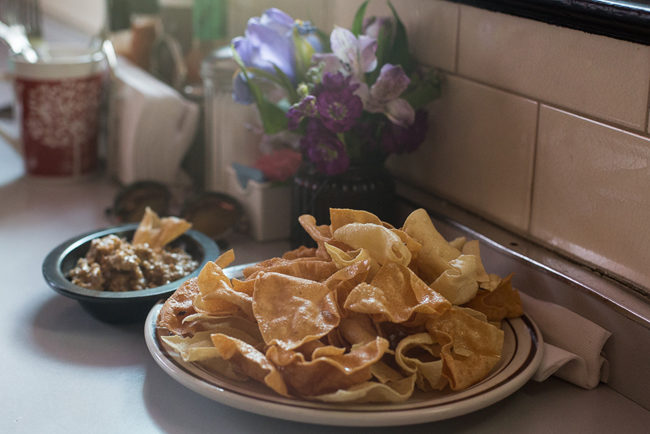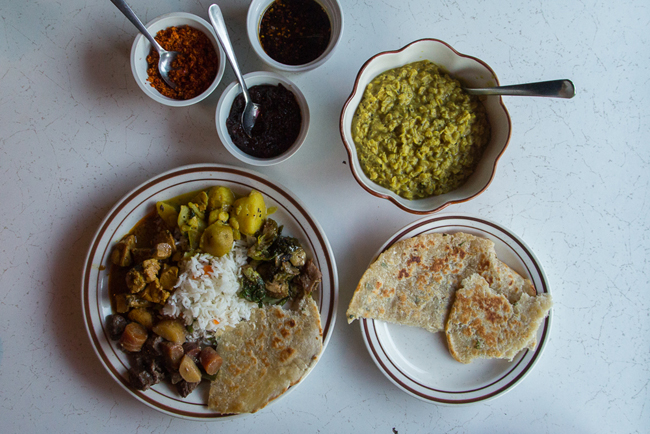
Heather Jansz just spread a good teaspoon — honestly, closer to a tablespoon — of coconut sambal onto a lentil chip. I, meanwhile, feel my eyes start to water in sympathetic pain. A few tiny flakes of the chunky red paste had been enough to perk up my potato curry. Surely, she can’t just pop that whole thing in her mouth. Surely —
But she does. And she is visibly revivified. After several hours on her feet, the hit of pure heat seems to be just what she craves.
Jansz describes herself as a “hot food addict.” (She may or may not be known to sneak her own condiments — sambals and hot sauces — into her bag when she eats out.) The cuisine of her native Sri Lanka is noted for being the hottest of the hot. It’s the sort of place where spicy foods and hot teas cool down bodies sweltering in the jungle heat.
Regulars at her Sri Lanka Curry House in Uptown, Minneapolis and the Curry Leaf Deli in St. Paul would come specifically for the heat. Like furtive visitors to a culinary dominatrix, they would beg for the hottest stuff, then let the sweat pour down their reddened faces as they ate.

Sri Lanka Curry House was once a Twin Cities destination. It was Jansz’s cooking home after she got her start at the now-closed Mulligan Stewhouse, a neighborhood Irish pub that let her put a curry on the specials board. An intrepid and influential restaurant critic discovered her, dug in, and dug it. “Jeremy Iggers gave me my first write-up. I owe him so much,” Jansz says. “He said, ‘Let’s give this Sri Lankan woman the chance to put her money where her mouth is.’” That is to say: Bring on the heat.
After the Curry House closed, Jansz cooked privately for clients, including health-conscious visiting celebrities, and wrote a cookbook. Then she stumbled into a foodie-era version of the Irish pub’s specials board: pop-up dinners. Through a neighbor, she met Danny Ziegler, owner of the 75-year-old diner Our Kitchen, a tiny white house that looks like it was left behind accidentally on the corner of 36th and Bryant, an errant boulder in the wake of a retreating architectural glacier.
Our Kitchen serves breakfast and lunch, closing at 2 p.m., and leaving the kitchen empty. So, twice a week, on most Wednesdays and Saturdays, Jansz and her team sweep in with trays — and trays and trays — of curries to serve two seatings of about 18 diners each. (Go to her website for upcoming dates and to reserve a spot.)

She makes about nine to 12 dishes — some meat, some vegetables, some 100 percent authentically Sri Lankan, some inspired by her Midwestern home and current culinary trends. She serves it all up family style, in a homey collection of bowls and plates that make you feel like a guest at her table.
One night last week, she treated the Heavy Table crew to the whole shebang. It was just what she would serve her pop-up guests, but was this the sort of spread one could expect at a Sri Lankan dinner table — ten separate dishes? She looked at me as though she didn’t quite understand how that could be a question, and suddenly I felt kind of guilty for my frequent reliance on one-pot meals.
But here’s the thing: Nothing on my plate was hot at all. At all. That famous Sri Lankan heat, at least the way Jansz serves it up, is all DIY. She showed us the proper way to fill a plate: a mound of rice with peas and carrots in the center, a ring of generous spoonfuls of curries around the outside, everything touching and melding and blending. Then comes the heat. Whether you just dip the tip of your spoon or drizzle with abandon, you add the heat. In addition to the coconut sambal, Jansz also passed dishes of what she calls “black gold,” her own brainchild: a viscous mix of rice bran and hemp oils infused with garlic, ginger, and toasted Thai chilis. More than just hot, it is deep, dark and smoky.

Our spread started with crackly lentil chips and a surprising chickpea chutney. Then dinner arrived in a fleet of dishes: beef stew, garam masala chicken, potatoes, Brussels sprouts with bacon (Jansz is a real Midwesterner now), a modern kale salad with sesame oil and a honey gastrique, chewy roti made with black-eyed pea flour, and — though it’s not regularly on the menu — a dish of pickled eggplant that would launch wars for its acquisition.
Every dish was distinct, deep, and complex, made with spice blends Jansz toasts and grinds herself. (Maybe someday we’ll find them on grocery store shelves? Here’s hoping.)
Jansz explained that she had planned the menu according to ayurvedic principles, to activate all of our senses. “So I can’t really be responsible for what happens after this,” she said slyly.
And it was nearly all gluten- and dairy-free, just naturally. (“There’s one bloody cow in Sri Lanka,” Jansz joked, “and he’s worshipped.”)
After platefuls of the stuff, it was remarkable to feel full — really sated — but not post-Thanksgiving-dinner gross.
“You’re supposed to feel good after you eat,” Jansz reminds us. “This stuff is really good for you. There’s no butter. There’s no fat. There’s no gluten. There’s no cream. This stuff is supposed to go in you and go out of you. Thanks to Dr. Oz, I can talk about that now.
“When I feed someone I feel like I’ve got to their soul a little bit,” Jansz continues. “I come from a place where everyone talks about taking care of their soul [in the afterlife]. But I believe we should take care of your soul now.”
“I love it. I truly love it. It’s exhausting,” she says of her work.
And she takes another generous dip of coconut sambal.


